Initiatives for Reducing Impacts on the Environment Back Number (2019)
Back to Latest Initiatives for Reducing Impacts on the Environment
Basic Approach
Atmospheric emissions and wastewater from plants can be a source of water, air, and soil pollution that poses a threat to local communities.
At the MinebeaMitsumi Group, we believe that harmony with local communities is indispensable to our business activities, and as such, we are striving to reduce our impact on the environment.
Through in-house environmental surveys conducted by the Group's Environmental Management Department, we are able to identify potential risks and prevent environmental accidents and violations of laws and regulations. Also, in order to enhance their effectiveness, company-wide environmental education and training are continuously conducted.
Results of Efforts and Challenges in FY2018
In order to comply with environmental laws and regulations in each country and region, the MinebeaMitsumi Group sets voluntary standards that are stricter than those in the national and local governments and conducts daily monitoring of wastewater discharge.
In FY2018, we further strengthened our daily monitoring and environmental patrols at all of our Group's factories to avoid disturbances to the surrounding areas, such as leaks, foul odors, noise, and vibrations.
Environmental risk management
Regarding diversifying environmental risks, the Environmental Management Committee supervised directly by the president and headed by Executive Officer Adachi will consider and take preventive measures against them.
In the event that environmental risks become apparent, members of the Group Environmental Management Department in Japan and environmental management members at overseas sites cooperate to share information, inspect related sites again, and take measures to prevent recurrence.
In order to maintain ISO 14001 certification, we receive external audits by third-party organizations once a year, and internal audits by internal auditors are also conducted once a year. If any issues are identified, we will promptly disclose and respond.
The MinebeaMitsumi Group ensures compliance with the environmental laws and regulations of each country and locality. For plant wastewater and other types of waste, we have established in-house environmental standards that exceed national and local regulations and monitor waste management.
In addition, we conducted environmental patrols at all Group plants to ensure there are no leaks, foul odors, noise, vibration or other issues that could inconvenience surrounding communities.
Plant Initiatives
Plant Wastewater Purification
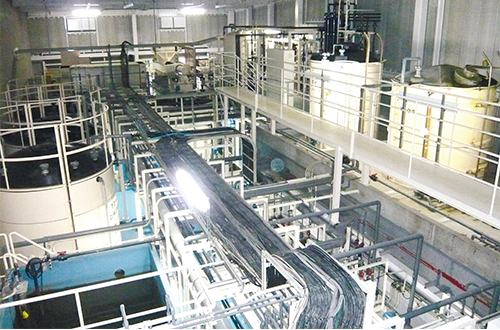
Fujisawa Plant's wastewater processing facility
Prior to releasing wastewater into rivers, MinebeaMitsumi Group plants use their own processing equipment to purify it within fixed environmental standards. These plants adhere to environmental laws of the countries and localities in which they operate, and independently monitor such wastewater discharges, including regular testing for such metrics as pH1, COD2, BOD3, SS4, and n-hexane extracts5.
- pH: A scale indicating whether substances are acidic or alkaline. pH7 is neutral. pH values below 7 indicate increasing acidity, while values above 7 indicate increasing alkalinity.
- COD (chemical oxygen demand): The amount of oxygen consumed to oxidize organic substances (pollution) in water. COD measurement takes less time than BOD measurement, but is less reliable. COD is generally used as a metric in wastewater management for sea, lake, and marsh waters.
- BOD (biological oxygen demand): The amount of oxygen required for bacteria to consume and decompose organic matter (pollution) in water. Higher values indicate greater degrees of pollution. Measurement takes several days. BOD is generally used to observe effluent water in rivers.
- SS (suspended solids): The volume of substances suspended in water. The higher the number, the greater the degree of water pollution.
- n-Hexane extracts: Substances extracted from oils and detergents that are difficult to volatilize in water using a substance called n-hexane as solvent. In this report they signify mineral oils.
Implementation of Environmental Patrols at Overseas Plants (Thailand, China)
Members of the Japanese Group Environment Management Department of the MinebeaMitsumi Group regularly visit overseas plants to implement environmental patrols together with members of the local environment management departments.
In FY2018, we conducted joint patrols at all plants in Thailand and China.

Wastewater treatment facilities at the Lopburi Plant in Thailand
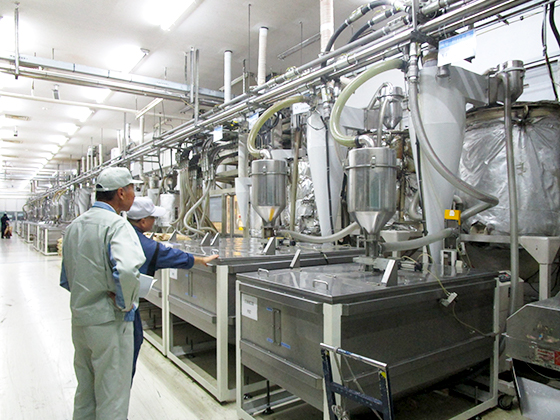
Resin drying equipment at the Xicen Plant in China
Observation of Waste Disposal Sites (Japan, Thailand)
Some waste material generated at plants and offices can be difficult to reuse or recycle at the plant or office. This type of waste material is outsourced to waste treatment companies for processing.
The MinebeaMitsumi Group selects reliable treatment companies for outsourcing processing and periodically visits the processing sites to observe the status of processing and management. We will continue to cooperate with treatment companies and take measures to prevent environmental contamination including soil, water, and air pollution during waste processing.
Members of the Japanese Group Environment Management Department, Thai Environment and Energy Committee, and representatives from the Rojana Plant and Ban Wa Plant conducted onsite tours of an industrial waste processor and recycling company in Thailand on August 7, 2018.
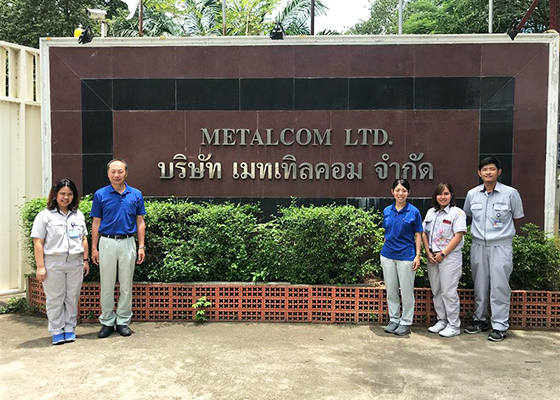
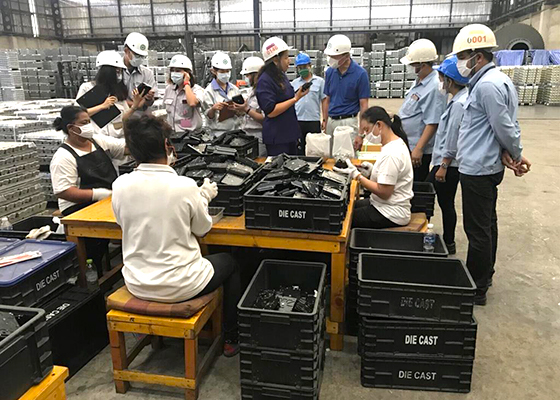
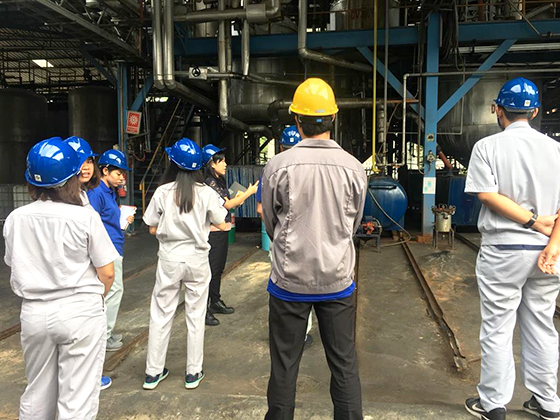
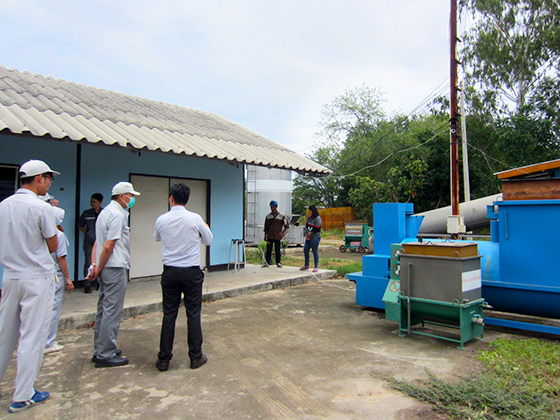
Members of the Japanese Group Environment Management Department and Thai Environment and Energy Committee observe a waste processing site
Operation of Plant Wastewater Zero System (Thailand & China)
The MinebeaMitsumi Group operates plants which use large amounts of water in the processing of manufactured products and take measures to reduce emissions of wastewater.
Our plants purify used water to reduce the level of waste to below standards required by each country and locality before releasing the water into the environment. Despite these measures, we cannot guarantee that the released water has zero impact on the surrounding environment.
At our plants in Thailand and China, which use large amounts of water, we have adopted the "Plant Wastewater Zero System" to reduce to as close to zero as possible the wastewater released and its impact on the environment.
In this system, the plants further purify wastewater that was previously treated and released into the environment, and then reuse the entire amount of wastewater internally at the plant without any external emissions.
Currently, this system is being used by the Bang Pa-in, Ayutthaya and Lop Buri plants in Thailand, as well as the Shanghai and Xicen plants in China.

Bang Pa-in Plant "Plant Wastewater Zero System"

Xicen Plant "Plant Wastewater Zero System" building
Management of PRTR-controlled Substances (Japan)
In accordance with the Pollutant Release and Transfer Register (PRTR) Law, all of our places of business in Japan manage the amounts of PRTR-controlled substances used and transported.
Reported Results for FY2018
| Control number | Substance name |
Volume handled | Emission Volumes | Transfer volumes | Volume consumed | Removal treatment | |||
|---|---|---|---|---|---|---|---|---|---|
| Air | Water | Landfill | Waste | Sewerage | |||||
| 71 | Ferric chloride | 3.10 | 0 | 0 | 0 | 0 | 0 | 0 | 3.10 |
| 349 | Phenol | 1.41 | 0.06 | 0 | 0 | 1.35 | 0 | 0 | 0.00 |
| 374 | Hydrogen fluoride and its water- soluble salts |
19.15 | 0.19 | 0 | 0 | 0 | 0.96 | 0 | 18.00 |
| 384 | 1-bromopropane | 9.31 | 7.85 | 0 | 0 | 0.62 | 0 | 0 | 0.84 |
| 438 | Methylnaphthalene | 3.29 | 0.07 | 0 | 0 | 1.46 | 0 | 0 | 1.77 |
| Total | 36.26 | 8.17 | 4.39 | 0 | 23.71 | ||||
BCP Training Drills and Waste Oil Spill Prevention Drills (Japan: Karuizawa Plant)
In November 2018, the Karuizawa Plant held its business continuity plan (BCP) training drill simulating the occurrence of a large-scale earthquake.
Details of training drills
- Establishment of disaster response headquarters
- Taking attendance of staff being evacuated
- Fire drill by internal fire brigade
- Oil spill response drill
etc.
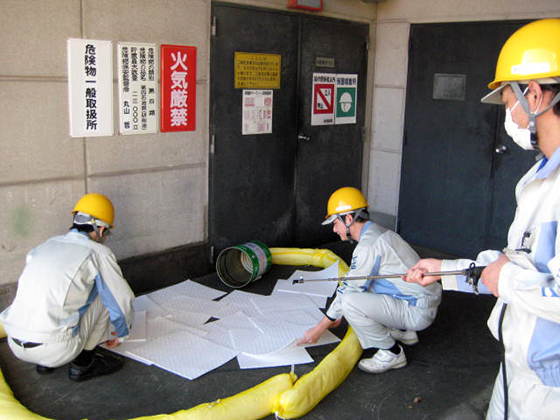
Oil spill response drill

Disaster response headquarters
Chemical Substance Leak Preparedness Training (China: Shanghai Plant and Xicen Plant)
The Shanghai and Xicen plants in China conduct emergency response training through chemical substance leak simulations. The Environmental Safety Committee at each plant conducts the training to minimize human injury and environmental pollution by taking appropriate measures in the event of a leak. The training is held annually for manufacturing division employees handling hazardous chemicals substances, suppliers of hazardous chemical substances, hazardous materials recovery companies, and cleaning companies.
In FY2018, 37 people participated in a training session at the Shanghai Plant on April 18.
Details of training drills
- Emergency contact method when there is a leak of hazardous chemical substances
- Human emergency response when there is a leak of hazardous chemical substances
- Briefing on use of emergency bucket and hands-on drill
etc.
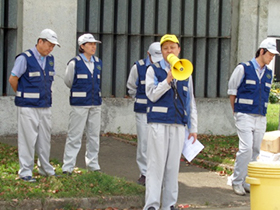

Chemical substance leakage preparedness training session at Shanghai Plant
Future Issues and Goals
The MinebeaMitsumi Group will continue to conduct business operations in compliance with environmental laws in Japan and around the world and is implementing countermeasures in areas where it has caused environmental contamination in the past.














